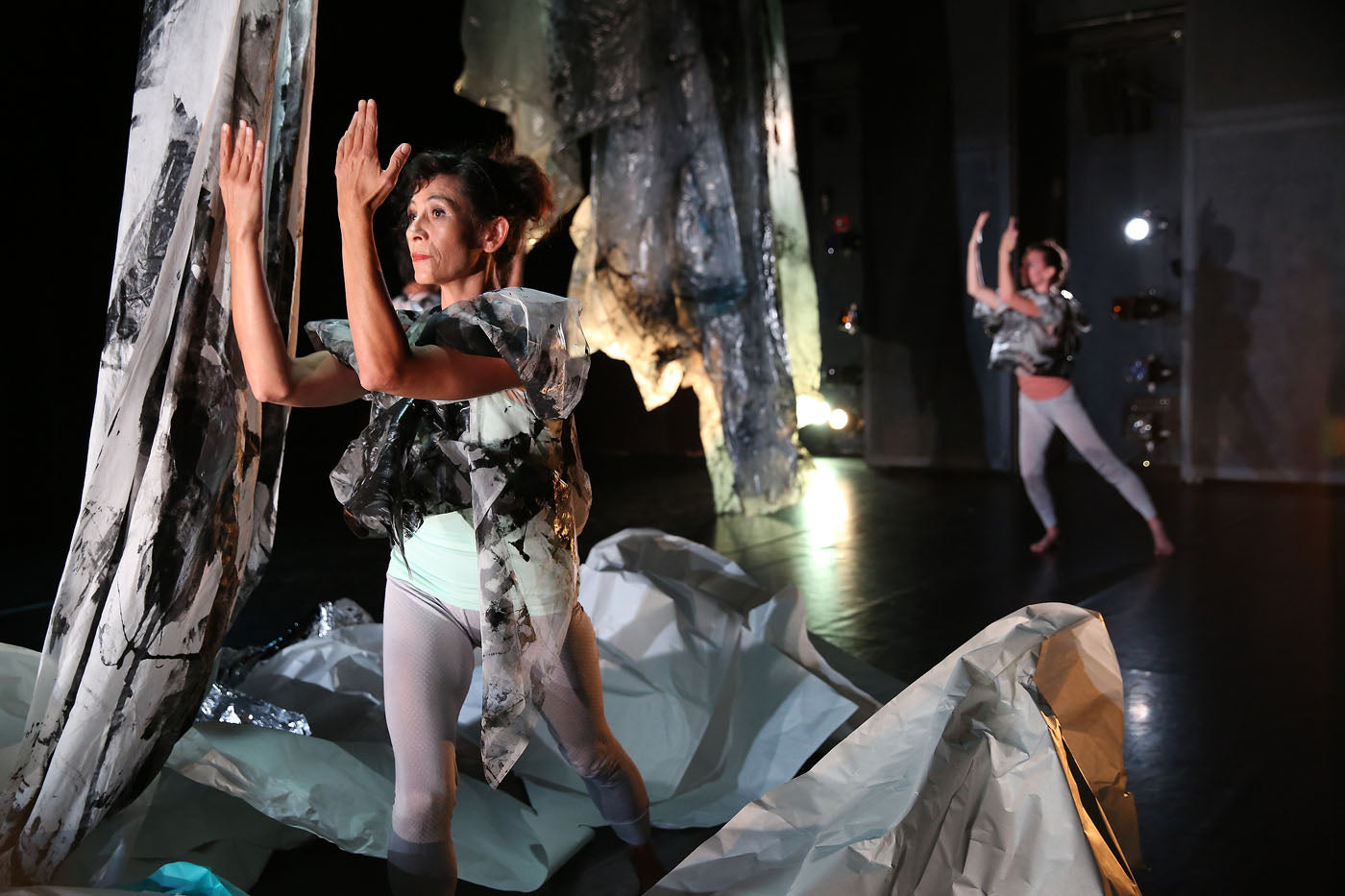The big heat was generated by choreographers Laurel Jenkins and Chey Chankethya, dancing their, “Soma Path,” with a vigorous score performed live by the composer, Miguel Frasconi. A melding of two traditions, Cambodian classical dance and American postmodern dance, the work was quirky, intriguing and beautifully presented. Jenkins, a member of Trisha Brown Dance Company from 2007-2012, is statuesque and, well, mutably articulate in her movement; Chankethya is short and equally clear in her vocabulary.
There was Jenkins, sporting an athletic type of mini-culotte dress and looking like an Olympic goddess—or a figure from a Greek frieze—standing in second position, her hands and arms slicing the air with a Cunningham-type concentration, the tiny but mighty Chankethya moving across the floor gingerly.
Meanwhile, Frasconi, making use of glass objects and a laptop, provided a provocative soundtrack that gave the duo an ethereal quality. Until, that is, the music accelerated and catapulted the couple into twenty-first century disco, the dancers bathed in Pablo Santiago’s lighting that ranged from sensual to stark.
Jenkins, occasionally swiveling her hips, also held solid balances, as Chankethya assumed the poses of her native Cambodia, knees bent, a supple back and extremely flexed fingertips that occasionally opened and curled as if a lotus blossom.
This was not a culture clash but a culture fest, with a light cue later revealing the pair in space cadet mode. Sporting goggles as if deities from another planet (costumes by Maria Garcia), and trying to ward off an apocalypse, Jenkins carried Chankethya piggy-back style, a playful but slightly forbidding mood accentuated by Frasconi’s sometimes disturbing, ostinato-ish score.
Warriors moving together, theirs was a sense of controlled passion, an exhilarating journey finally ending at the back of the stage, where the door to REDCAT’s warehouse slowly opened and the odd-but-endearing couple walked into another realm, one where memories and clues, perhaps, to other lives, lay dormant.
Rebecca Pappas’ “Plastic Flow,” a tired nod to recycling, paper vs. plastic and environmental chaos, featured dancers Arian Winn, Roberta Shaw and Louie Cornejo. The work was set amid an untidy mound of paper and painted fabric, from which the trio emerged. There was also a rather unsightly sculpture reminiscent of a shower curtain that was suspended from the ceiling (scenic construction by Matthew Eben Tomás).
Echoing the set, the dancers were clad in Jill Spector’s lumpy costumes that vaguely recalled the outrageous designs of Comme Des Garçons’ Rei Kawakubo, who famously collaborated with Merce Cunningham on irregularly-bulged garb from his piece, “Scenario.” Alas, Pappas’ choreography, Butoh-tinged and replete with quivering buttocks and dollops of balancing, was far from the glacier, slo-mo moves of, say, a Robert Wilson, and quickly lost appeal.
Even Joe Court’s taped sound design—requisitely ominous with deep rumblings—was more irritating than memorable. Indeed, the best part of this work was when a very pregnant soprano, Karina Kallas, appeared and began to sing, unrecognizably at first, “Dido’s Lament,” from Purcell’s Dido and Aeneas.
The words, “When I am laid in earth …” performed with a startling lack of pretense, may have given voice to a dying civilization, but they could not dispel the waste that characterized Pappas’ lackluster dancemaking, Christopher Kuhl’s evocative lighting notwithstanding.
On a livelier—and certainly more wacky—note: Noodlerice Studio’s “Untitled,” a romp through bizarro-land that featured Cordelia Istel, Anatoliy Ogay, Jessica Barrett Denison and Kevin James Whitmire. Created and directed by Liang Guo and Yao Zhang, the work served up visual and vocal high jinx: a balloon-headed body decked out in a black suit, a person wearing giant, slinky-like movable armor that turned into an elongated set piece with individual and group masturbation (funny, but ultimately belabored), and a woman speaking the brilliant, minimalist words—riffs on unhappiness, really—of Gertrude Stein.
With the prickings of the balloon-head, giant bubbles being blown and snippets of “Auld Lang Syne” wafting in (sound design by Jesse Mandapat; music and additional sound by—yes—Pokemon Go and The Knife), there was something for everyone in this work.
Or maybe not, as the sex stuff carried over into what looked to be a giant condom, while a weird tent made of aluminum foil also proved surrealistically enigmatic. But unlike so many performance collectives that have no sense of editing, i.e., when to end a work (after all, tangents can be taken at any time and at any place in the worlds of Stein, Dalí, et al), Noodlerice Studio chose to end its rather abruptly, with Chu-hsuan Chang’s lighting going to black, something that, appropriately, confused the audience.
A perfect end, actually, to an otherwise somewhat imperfect evening.









comments